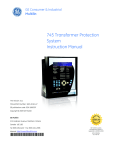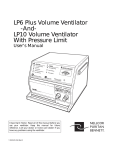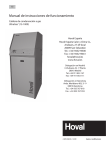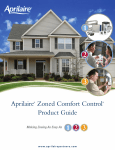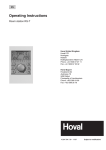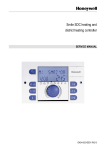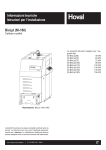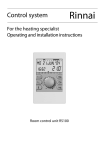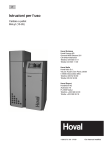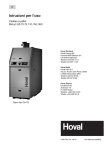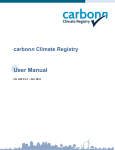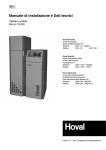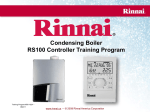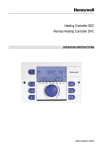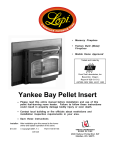Download EN Operating Instructions BioLyt (50,70,75) BioLyt
Transcript
Operating Instructions BioLyt (50,70,75) BioLyt (100,110,130,150,160) Wood pellet boiler United Kingdom Hoval Ltd. Northgate Newark Nottinghamshire NG24 1JN Phone +44 1636 67 27 11 Fax +44 1636 67 35 32 Export Hoval Aktiengesellschaft Austrasse 70 9490 Vaduz Principality of Liechtenstein Phone +423 399 24 00 Fax +423 399 24 11 Figure: BioLyt (50-75) Figure: BioLyt (100-160) Subject to modifications | 4 212 945 / 00 - 04/14 EN 1. Information about your heating system.............................................................................. 4 2. Important information........................................................................................................... 5 3. Functional principle of the heating system........................................................................ 7 4. Heating system control...................................................................................................... 11 1.1 1.1.1 1.1.2 1.2 1.3 2.1 2.2 2.3 2.4 3.1 3.2 4.1 4.2 4.3 4.4 4.4.1 4.4.2 4.4.3 4.4.4 4.5 4.5.1 Fuel quality / pellet delivery.................................................................................................................... 4 Fuel quality................................................................................................................................................. 4 Pellet delivery............................................................................................................................................. 4 Important addresses and telephone numbers...................................................................................... 4 BioLyt (50-160) wood pellet boiler.......................................................................................................... 4 Key to symbols used............................................................................................................................... 5 Safety information.................................................................................................................................... 5 Entering the pellet storage room, storage tank..................................................................................... 5 Cautionary notes...................................................................................................................................... 6 What happens inside the BioLyt?.......................................................................................................... 9 How are the pellets extracted and conveyed from the storage room?............................................. 10 What is the function of the boiler controller TopTronic® T.................................................................. 11 How you can save energy..................................................................................................................... 11 Basic display.......................................................................................................................................... 11 Operating and display elements........................................................................................................... 12 Function of the operating elements.......................................................................................................... 12 Basic procedure for changing settings..................................................................................................... 12 What to do if ............................................................................................................................................ 13 Control elements on the boiler control panel............................................................................................ 14 Main settings.......................................................................................................................................... 16 Changing the room temperature.............................................................................................................. 16 4.5.1.1 4.5.1.2 Setting the desired room temperature, day.................................................................................................................16 Setting the desired reduced (night-time) temperature................................................................................................17 4.6 4.6.1 4.6.2 4.6.3 4.6.4 Operating modes.................................................................................................................................... 18 Function of the operating modes.............................................................................................................. 18 Operating modes for holiday and absence?............................................................................................. 19 Changing the operating mode - for "HOLIDAY TIL," "ABSENT TIL" and "PARTY TIL"............................. 20 Changing the operating mode - for "AUTOMATIC," "SUMMER," "HEATING," "RED. HEATING" and "STANDBY".............................................................................................................................................. 21 Switching times (heating times)........................................................................................................... 22 Standard heating times............................................................................................................................ 22 Table for recording individual switching times.......................................................................................... 22 Changing the switching times (heating times).......................................................................................... 23 Copying switching times........................................................................................................................... 26 Heating curve......................................................................................................................................... 28 Heating curve (heating characteristic curve)............................................................................................ 28 Changing the heating curve (heating characteristic curve)...................................................................... 29 Hot water................................................................................................................................................. 30 Setting the domestic hot water temperature............................................................................................ 30 Manual DHW re-charging......................................................................................................................... 31 Domestic hot water economy temperature (reduced temperature).......................................................... 32 Further settings...................................................................................................................................... 34 Setting the clock....................................................................................................................................... 34 Setting the date........................................................................................................................................ 35 Changing between summer and winter time............................................................................................ 35 Setting the language................................................................................................................................ 36 Reloading the standard switching times program - Deleting your own time program.............................. 37 Manual operation .................................................................................................................................... 39 4.7 4.7.1 4.7.2 4.7.3 4.7.4 4.8 4.8.1 4.8.2 4.9 4.9.1 4.9.2 4.9.3 4.10 4.10.1 4.10.2 4.10.3 4.10.4 4.10.5 4.10.6 2 Table of contents 4 212 945 / 00 4.11 4.11.1 4.11.2 4.11.3 4.11.4 4.11.5 4.11.6 4.11.7 System information................................................................................................................................ 40 Information key for system temperatures and heating circuit information................................................ 40 Information on the boiler status................................................................................................................ 41 Displaying and resetting the consumption meters and cleaning messages............................................. 43 Changing off-periods for the extraction system........................................................................................ 46 Special symbols....................................................................................................................................... 49 Maintenance message............................................................................................................................. 49 Optional accessories................................................................................................................................ 50 5. Fault repair.......................................................................................................................... 51 6. Checking the water level.................................................................................................... 56 7. Maintenance BioLyt (50-75)................................................................................................ 57 8. Maintenance BioLyt (100-160)............................................................................................ 60 9. Emptying the ash box and resetting the counter............................................................. 63 5.1 5.2 5.3 5.4 5.5 5.6 Blocking switch and reset button......................................................................................................... 51 Display of heating regulator alarms..................................................................................................... 51 Display of boiler controller alarms....................................................................................................... 51 Overview of alarms, heating regulator TopTronic®T............................................................................ 52 Overview of alarms, boiler controller................................................................................................... 54 Checklist in case of faults..................................................................................................................... 55 7.1Commissioning...................................................................................................................................... 57 7.2 Regular checks....................................................................................................................................... 57 7.3 Cleaning the boiler................................................................................................................................. 57 8.1Commissioning...................................................................................................................................... 60 8.2 Regular checks....................................................................................................................................... 60 8.3 Cleaning the boiler................................................................................................................................. 60 9.1 Resetting the message "empty ash box" (W:40)................................................................................ 63 10. How you can save energy.................................................................................................. 64 11. Instructions on proper disposal of individual system components.............................. 64 4 212 945 / 00 Table of contents 3 1. Information about your heating system Dear heating system owner, With the purchase of this Hoval BioLyt (50-160) wood pellet boiler, you have made an excellent choice. It offers you all the advantages of a modern and efficient heating system. Please read these instructions carefully. They describe how the boiler works, how it is operated and serviced. Further information can be obtained from our Sales and Service Centres. (See last page for contact details). 1.2 Important addresses and telephone numbers Heating engineer__________________________ ________________________________________ ________________________________________ Plumber__________________________ ________________________________________ ________________________________________ Electrician__________________________ ________________________________________ ________________________________________ 1.1 1.1.1 Fuel quality / pellet delivery Fuel quality The BioLyt (50-160) wood pellet boiler has been designed for optimum combustion of wood pellets. The pellets must meet the requirements of at least one of the standards listed below • ÖNORM M 7135 • DIN 51731 / HP5 (DINplus) • SN 166000 • EN 14961-2 / A1 (ENplus/A1) Hoval recommends ENplus (Class A1): Master chimney sweep_________________________ ________________________________________ ________________________________________ 1.3 BioLyt (50-160) wood pellet boiler To be completed by the heating engineer: Order No. / Manufacturing No.:__________________ Boiler type:__________________________________ Boiler power rating:________________________ kW Hot water buffer storage tank size (if present):______ Calorifier size:_______________________________ Heating pump type:___________________________ Heating regulator type:________________________ Mixing valves type:___________________________ Calculation basis for heating system 1.1.2 Pellet delivery • Do not fill the storage room until after initial commissioning of the boiler. • Switch off the heating system as instructed 15 min. before filling the storage room. • To measure pellet consumption since the last delivery, reset the counter "USAGE 1." You can measure consumption over a specific period of time (e.g. annual consumption) by always resetting the counter on a specific date (e.g. January 1). For further information, see Chapter 4.11.03. 4 Information about your heating system Lowest outside temperature:__________________ °C Energy demand:__________________________ kW Max. flow temperature:______________________ °C 4 212 945 / 00 2. Important information 2.1 •Parents must keep their children away from the boiler room; the heating system is not a toy! Key to symbols used Please pay particular attention to the following symbols used in this operating manual. i 2.2 Failure to observe instructions to this effect can lead to danger to persons. •Do not burn unsuitable fuel (see Chapter 1.1); otherwise, any possible warranty claims will become invalid. Failure to observe instructions to this effect can lead to malfunctions or damage to the boiler or the heating system. • Do not carry out any modifications to the system (possible danger to persons; possible loss of warranty). The marked sections of text contain information and tips on operating and running the system. Safety information (Information for the protection of persons) •Caution Switch off the heating system as instructed 15 min. before filling the storage room. Press the blocking switch. •Keep the air supply to the boiler room open: Air inlets and outlets must not be closed. It is important to ensure that the combustion air required for correct operation of the boiler can flow unhindered in order to protect operating personnel from an oxygen-depleted atmosphere. • Do not operate the boiler with the doors or pellet hopper open (danger of burn-back). In addition, any sparks emitted from the boiler could cause a fire. • The system must be cleaned regularly, otherwise any possible warranty claims will become invalid. 4 212 945 / 00 2.3 Entering the pellet storage room, storage tank Under unfavourable circumstances, an increased concentration of harmful gases (such as carbon monoxide) may occur in pellet storage rooms, possibly posing a risk when accumulating over a longer period of time. Despite the fact that under normal circumstances, there is no risk at all, the possibility of such a scenario cannot be ruled out. • If work is being carried out in filled storage rooms, a second person must always be present outside the room for safety reasons. • The pellet storage room must always be thoroughly aerated before anyone enters it. The storage room must be ventilated for at least 15 minutes. In the case of pellet storage rooms with a volume of more than 10 t, the duration of ventilation must be extended or mechanical ventilation provided. • No-one should enter the storage room in the four weeks following filling. If it is necessary for persons to enter the storage room, the room must be ventilated for at least 2 hours before entering. • It must be ensured that the storage room door remains open while there are persons inside the storage room. • Entering fuel storage rooms that have not been aerated (particularly underground tanks) must be avoided, and only trained personnel is permitted to do so. Before entering the room or tank, the concentration of CO must be measured (the concentration must be less than 30 ppm). If necessary, thoroughly aerate the storage room or tank before entering it. Important information 5 • It the storage area is difficult to access or if it is accessible only from above (as in the case of underground tanks), the person entering the tank must be additionally secured. • Keep children away from the pellet storage area! • If there are moving parts (worm conveyors) in the storage room, turn off the mains switch of the heating system before entering the storage room, as otherwise there is a risk of injury. • Smoking, naked flames and other possible sources of ignition are prohibited inside the storage room. 2.4 Cautionary notes (Information on the protection of the heating system) Checking the water level Check the water level in the system at regular intervals (see Chapter 6). Filling the heating system The heating system can normally be filled and topped up with mains water. No chemical additives should be added to the water. The water quality can vary greatly in different parts of the country (you can obtain information about the water quality from your local water company), and it might not always be suitable for filling the heating system (highly corrosive or very hard water). Please contact your heating engineer in such cases (see also Technical Information). Circulation pumps During the periods when no heating is required, the circulation pumps should be operated for approx. 2 minutes at least once every month. This will prevent the pumps from seizing up. Operation and cleaning Periodic cleaning and inspection by the heating engineer or Hoval customer service will not only extend the service life of the pellet boiler, but also increase its operating safety and ensure that a high combustion efficiency is maintained. • In winter mode, the boilers must be cleaned approx. every 2 weeks by means of the special tool supplied and a vacuum cleaner with ash retainer. • Pellet storage rooms must be cleaned regularly (approx. every 3-4 years), and the sawdust which has accumulated must be disposed of! • Large-scale pellet-fired systems must be monitored on a daily basis when operated in winter at full load. The pellet storage rooms and discharge systems must also be checked for fault-free operation and to ensure that the supply of pellets is sufficient. Protecting the boiler Do not use sprays, solvents, chlorine based cleaning products, paint, adhesives etc. in the proximity of the boiler. These substances can cause corrosion inside the boiler and the flue gas system. Pressure relief valve, backfire protection and thermal discharge safety device The correct functioning of the various safety devices (pressure relief valve on the heating installation, backfire protection valve on the burner, pellet hopper seal, thermal discharge safety device) must be checked periodically by the heating engineer. The heating installation must be inspected regularly according to local regulations. For Austria only In Austria, with industrial plants exceeding 50 kW, the FAV ordinance for combustion plants must also be observed. Tightness / Burn-back protection The doors and pellet hopper must be checked for leaks on an annual basis. Smoke leaks should be avoided in order to prevent any toxic low-temperature gases from escaping into the boiler room. Moreover, leaky doors or a faulty pellet hopper seal could cause the embers to burn back into the pellet burner. . 6 Important information 4 212 945 / 00 3. Functional principle of the heating system It is important that the perfectly coordinated individual components function properly to ensure that your home stays warm in winter. COMPONENTS Wood pellet boiler Pellets The process of combustion within the boiler converts the natural energy contained in the pellets into heat. Optional heating water buffer storage tank It is used for intermediate storage of hot heating water (max. 90°C). It thus compensates for any differences between heat generation and demand. Storage calorifier Holds a reserve of domestic hot water for household consumption (e.g. for showering). Boiler controller with heating regulator Controls and monitors the operation of the boiler. Maintains the desired room temperature optimally and fuel-efficiently, independent of the outside temperature. Radiators underfloor heating, if fitted 4 212 945 / 00 FUNCTION: Burns the pellets safely and in an environmentally friendly manner.. Extracts the heat from the combustion gases and transfers it to the heating water. Releases the heat of the heating water into the room. Heating pump Transports the heating water from the boiler to the radiators and back into the boiler, where it is reheated. Heating water and heating pipes Transports the heat which is generated from the boiler to the radiators. Functional principle of the heating system 7 Mixing valve Adjusts the heating flow temperature to the radiator to maintain the desired room temperature whatever the outside temperature. This is achieved by mixing in colder return heating water. Pressure gauge Displays the water pressure in the heating system. Air vent Ensures that the heating pipes contain only heating water and no air. Safety valve Prevents overpressure in the system. Membrane expansion tank Maintains the pressure in the system at a constant level and absorbs the expansion water. Depending on the type of heating system selected, some of the components might not be present or others added. The heating engineer will explain the system to you. Radiators underfloor heating, if fitted Heating pump Mixing valve Wood pellet boiler Calorifier Hot water buffer storage tank (optional) 8 Functional principle of the heating system 4 212 945 / 00 3.1 What happens inside the BioLyt? The Hoval BioLyt has been designed for the lowemission combustion of wood pellets in accordance with ÖNORM M 7135 and DIN 51731, HP5 (or DINplus), as well as EN 14961-2, A1 or ENplus. The metering screw conveys the wood pellets from the pellet hopper to the feeder screw via a downpipe with rotary valve. The metering screw adjusts the amount of pellets conveyed as a function of the power demand, while the continuously operating feeder screw feeds the pellets into the burner pipe. Degassing of the pellets takes place in the rear section of the burner pipe by means of primary air supplied by the pressure fan. The combustible gas thus generated is thoroughly mixed with secondary air (supplied by the induced draught fan) in the front section, where it burns cleanly and completely with low emission levels. The horizontal combustion results in a flame similar to that of an oil or gas burner. The combustion system achieves an excellent pellet burn-out rate. Thanks to the large, mostly refractory lined combustion chamber, it is possible to attain a long dwell time of the hot gases as well as sufficiently high combustion temperatures. These factors contribute to a further optimisation of the burn-out quality. The heat exchange between the hot gases and the heating water takes place by means of the proven thermolytic secondary heating surface. The secondary heating surface is cleaned fully automatically. The ashes arising as a result of the combustion process are collected in the combustion chamber and are periodically conveyed to the ash container by the ash discharge screw. Figure: BioLyt (100-160) Fig. 01 4 212 945 / 00 Functional principle of the heating system 9 3.2 How are the pellets extracted and conveyed from the storage room? The pellets are extracted from the storage room by means of a worm conveyor and then transported to the pellet hopper on the boiler by means of a vacuum turbine. The pellet hopper on the boiler includes two filling level indicators: - for the signal “pellet hopper full” / top - for the signal “pellet hopper empty” / bottom The extraction system can be disabled during two periods of time per day (e.g. to avoid unwelcome noise during the night). The factory settings are from 12.30 p.m. to 2.30 p.m. and from 9.30 p.m. to 8.00 a.m. To ensure that there is an adequate supply of pellets to span such off-periods, forced burn-out with filling of the pellet hopper is carried out 30 min. before the beginning of every off-period. Off-periods can be deactivated by setting the beginning and end of the respective period to 00.00 (see Chapter 4.11.4). The pellet hopper can only be filled during the preset enable time in order to minimise the noise in the building. The filling process is started every time the burner enters burn-out mode or, at the latest, when the bottom fill level indicator signals “empty”. First, the suction turbine starts up. Then, the discharge screw starts operating after a delay of approx. 15 secs. As soon as the upper filling level indicator sends the signal for “pellet hopper full”, the discharge screw is stopped; the suction turbine then stops operating after a set time delay (for purging the hoses). Suction turbine under sound absorbing hood Discharge screw Screw motor 10 Functional principle of the heating system Fig. 02 4 212 945 / 00 4. Heating system control 4.1 What is the function of the boiler controller TopTronic® T i ENERGY 4.2 i The boiler controller, together with the temperature sensor connected to it, is, so to speak, the brain of the heating system. Its main functions are: -- maintaining the desired room temperature independent of the outside temperature -- heating the living space when required -- producing warm water (e.g. for showering) only when required -- displaying information Further functions: -- input of desired temperatures and operating modes -- turning the heat generator ON/OFF -- monitoring temperatures The correct settings for the heating system have already been applied by Hoval, or the installer, during commissioning. Any changes to those settings should only be carried out if you go away on a trip or if your home is too cold or too warm. You can find an overview of the most frequently asked questions and the answers to them in Chapter 4.4.3. How you can save energy For your benefit and for the environment, use energy efficiently and avoid unneccessary losses: With little effort, you can optimise the operation of your system and make it worth while. It is worth turning the heating off again during spells of warm weather in autumn to prevent your heating system generating unnecessary heat when outside temperatures are low in the morning and thus overheating your home. Turning the heating on or off depending on the weather conditions is one of the most effective energy-saving measures. If you want to save yourself the effort of going down into the cellar, you may want to consider acquiring a “remote control” from Hoval, which will allow you to operate and control the heating comfortably from your living room. 4.3 Basic display The basic display shows the day of the week, date and time as well as the current heat generator temperature or another temperature (systemdependent). 4 212 945 / 00 Heating system control 11 4.4 Operating and display elements 4.4.1 Function of the operating elements The central PUSH & TURN button and the labelled keys are designed for easy and straightforward operation. PUSH & TURN button: Change and store values Function keys 4.4.2 Function keys Basic procedure for changing settings An example Select the desired function Turn the PUSH & TURN button to select or change the desired parameter (flashing word or number) Press the Info key at any time to return to the basic display without storing the values set Press the PUSH & TURN button to store the value set It is also possible to store the value using the selected function key. 12 Heating system control 4 212 945 / 00 4.4.3 What to do if ... The following information can be used as a first level support in frequently occurring situations. Observation Remedy It is too cold Set higher values for the room temperature with (Chapter 4.4.1). and the rotary button It is too warm Set lower values for the room temperature with (Chapter 4.4.1). and the rotary button From now on, equal day and night temperatures should be maintained continuously Use This evening, I want the heating to remain on for longer Use to set the operating mode to "PARTY" and set the desired time (Chapter 4.6.1, 4.6.3). I require a larger amount of hot water at the moment Press 4.9.2). From now on, hot water but no heating is required Use to set the operating mode to "SUMMER" (heating off, hot water only) (Chapter 4.6.1, 4.6.4). Suddenly, there is no heating or hot water; it is cold. Check the heating regulator and boiler controller for alarms (Chapter 5.2, 5.3) and consult a heating engineer if necessary The room temperature setpoint requires frequent adjustments because it is too cold or too hot Change the set heating curve (Chapter 4.8.2). Changing the heating curve does not make sense if your system is fitted with a room air sensor (or room station) and an outside sensor. The correct settings for the heating curve are then provided automatically. Consult a specialist if necessary. I will be absent for several hours during the day today Use to set the operating mode to "ABSENT TIL" and set the time of your return (Chapter 4.6.1 - 4.6.3). I am going away on a short trip (e.g. 3 days) Use to set the operating mode to "HOLIDAY TIL" and set the date of your return (Chapter 4.6.1 - 4.6.3). I am going away for an indefinite period of time In summer, it is too cold or too warm. 4 212 945 / 00 Use to set the operating mode to "HEATING" (Chapter 4.6.1, 4.6.4). for 3 seconds and set the additional re-charging time (Chapter to set the operating mode to "RED. HEATING." On your return, use to set operating mode "AUTOMATIC" (Chapter 4.6.1, 4.6.2, 4.6.4). Indicates that the summer disconnection is active. If it is too cold for you, use to set operating mode "HEATING" (Chapter 4.6.1, 4.6.4). Heating system control 13 4.4.4 10 9 8 7 Key Control elements on the boiler control panel 6 2 11 12 4 14 5 1 Designation Function Blocking switch Switch off and block the boiler (e.g for cleaning). 1 2 3 13 A 2nd electronic heating regulator can be installed here (for 2nd residential unit) if required. Daytime room temperature Set the daytime room temperature. Chap. 4.5.1.1 3 Reduced room temperature Set the night-time room temperature (reduced heating). Chap. 4.5.1.2 4 Domestic hot water temperature Set the domestic hot water temperature. Manual DHW re-charging. Chap. 4.9.1, 4.9.2 Push & Turn button Change the values by turning. Acknowledge the values by pressing. Select functions by pressing and turning. Information key • Show operating data on the display • Return to the basic display without saving the values. Ex. 4.11.1 Heating characteristics Set the heating curve 5 6 7 14 Heating system control Chap. 4.8.2 4 212 945 / 00 Key Designation Function 8 Operating mode selection key Select the operating modes Turn off the heating system while you are on holiday Holiday (frost protection) Chap. 4.6.1 - 4.6.3 Switch off the heating temporarily Chap. 4.6.1 - 4.6.3 Absence Extend heating operation Chap. 4.6.1 - 4.6.3 Party Automatic heating according to the preset heating Automatic times = normal heating operation Chap. 4.6.1, 4.6.4 Hot water only, heating off Chap. 4.6.1, 4.6.4 Summer Constant heating mode Chap. 4.6.1, 4.6.4 Heating reduced heating operation Reduced heating Constant Chap. 4.6.1, 4.6.2, 4.6.4 Standby 9 Manual mode / emission measurement 10 Display System off - frost protection active Chap. 4.6.1, 4.6.2, 4.6.4 For heating technician only or for preliminary acknowledgement of a maintenance prompt (see chap. 4.11.6). The basic display shows the day of the week, date and time, as well as the current heat generator temperature or another temperature (system-dependent). 1 6 2 3 7 4 5 Possible readouts: 1 Active heating time 24h 2 Day display 3 Display of the active operating state and the clock programme 4Time 5 Selected operating mode 6 Date / Day / Month / Year 7 Heat generator temperature or another temperature (system-dependent) 11 Control panel fuse, under the hinged cover Check the 6.3 A fuse if all displays remain dark. This may only be done by the heating technician! 12 Reset button, under the hinged cover Press the Reset button under the hinged cover if the display shows “Error.” If this happens frequently, notify your Customer Service centre. 13 Brief operating instructions Special brief operating instructions are provided with in the hinged cover the boiler controller. 14 Burner fault light 4 212 945 / 00 Press the Reset button (see no. 12) Heating system control 15 4.5 4.5.1 Main settings Changing the room temperature i These adjustments can also be carried out on a room station. 4.5.1.1 Setting the desired room temperature, day Mo 16 AUG.'04 Start - Basic display 14 / 00 / 62.5 1 Tap the “Daytime room temperature” key. 2 i If “MC1” is shown on the display, ROOM DAY The daytime room temperature setpoint flashes. 20.0c 3 Set the desired room temperature by turning the “PUSH & TURN button.” you need to select the heating circuit. (Information on which heating circuit to select for your home can be found on page 4 of these instructions). i Setting range 5 - 30°C (Factory setting 20°C) 4 ROOM DAY The new “Daytime room temperature” setpoint appears on the display. 22.0C 5 6 16 Tap the "Daytime room temperature" key to acknowledge the temperature setpoint. Heating system control 4 212 945 / 00 4.5.1.2 Setting the desired reduced (night-time) temperature Mo 16 AUG.'04 Start - Basic display 14 / 00 / 62.5 1 Tap the “Reduced room temperature” key. 2 ROOM NIGHT The night-time room temperature setpoint flashes. 20.0C i If “MC1” is shown on the display, you need to select the heating circuit. 3 Set the desired room temperature by turning the “PUSH & TURN button.” i Setting range 5 - 30°C (Factory setting 16°C) 4 ROOM NIGHT 18.0C The new “Reduced room temperature” setpoint appears on the display. 5 6 4 212 945 / 00 Tap the "Reduced room temperature" key to acknowledge the temperature setpoint. Heating system control 17 4.6 4.6.1 Operating modes Function of the operating modes Operating mode Function Application HOLIDAY - Heating system off while you are on holiday. - Room temperature set to minimum (10°C). - Calorifier frost protected (5 °C). You are going on holiday for e.g. 1 week and you know the date of your return. Chap. 4.6.2, 4.6.3 i ABSENT End of holiday = Return date. Normal heating is resumed on the day of your return! Setting range: current date + 250 days. To switch back to automatic mode prematurely - press the "operating mode selection key" - Heating system OFF (heating temporarily switched off until set time). - Room temperature set to minimum (10°C). - Calorifier frost protected (5 °C). i PARTY i You leave home in the morning and come back in the evening. Chap. 4.6.2, 4.6.3 Setting range: 0.5 - 24 h. To switch back to automatic mode prematurely - press the "operating mode selection key" conds. -Extend heating operation (daytime room temperature) up to set day/night time (you do not want to reduce the room temperature at the preset time). Setting range: 0.5 - 24 h. You have guests in the evening. - Automatic heating mode according to the heating times set in the 1st switching times program = normal heating mode. i SUMMER i HEATING RED. HEATING STANDBY 18 for 3 se- for 3 se- You want to heat as cost effectively and efficiently as possible. Chap. 4.6.4 06.00 - 22.00 22.00 - 06.00 05.00 - 22.00 - Heating system OFF - DHW is produced at the times set in the switching times program (for showering, etc.) - Frost protection active. Factory setting: Heating: Reduced heating: Domestic hot water: Chap. 4.6.3 To switch back to automatic mode prematurely - press the "operating mode selection key" conds. AUTOMATIC for 3 seconds. Heating the rooms is unnecessary due to the high outside temperatures. Chap. 4.6.4 Factory setting for domestic hot water: 05:00 - 22:00 Operating mode “Summer” cannot be selected if each heating circuit is adjusted separately. - The room temperature is not reduced during the night. -The rooms are continuously heated at the set “daytime room temperature" . - DHW mode according to switching program. You would like to heat the rooms during the night, too. Chap. 4.6.4 - The rooms are continuously heated at the "Reduced room temperature." - Continuous reduced heating mode. You are going away for an indefinite period of time. Chap. 4.6.2, 4.6.4 - Heating system OFF. - Frost protection active. - No DHW mode. You are travelling for an indefinite period of time in spring or in autumn. It does not matter if the rooms are cold on your return. You do not need warm water on your return. Chap. 4.6.2, 4.6.4 Heating system control 4 212 945 / 00 4.6.2 Operating modes for holiday and absence? Depending on how long you will be away and what your requirements are with regard to comfort, there are different operating modes available for interrupting or reducing the heating. In any case, you will save a lot of energy and money if the rooms are not heated or heated less during your absence. The following table is intended as a guide for finding the best operating mode for each particular case: Application Operating mode Function You are going on holiday for e.g. 1 week and you know the date of your return. "HOLIDAY TIL" -Heating system OFF / Calorifier frost protected (5°C) - Room temperature set to minimum (10°C) Setting range: from current date to 250 days in the future! End of holiday = Return date. Normal heating is resumed on the day of your return! Early return: Press for 3 sec. to return to dann "AUTOMATIC" (Chap. 4.6.1, 4.6.3). Heating system and DHW off while you are on holiday. You leave home in the morning and come back in the evening. "ABSENT TIL" Heating temporarily interrupted until set time. Setting range: 0.5 - 24h Heating interrupted temporarily You will be away for an indefinite period of time and want the living area to be at the set reduced temperature on your return. "RED. HEATING" You will be away for an indefinite period of time during spring or autumn and you don’t mind if your home is cool on your return. "STANDBY" Continuous reduced heating mode System off - frost protection active Continuous reduced heating and DHW mode (reduced, see Chap. 4.9.3) around the clock. The entire heating system is switched off and frost-protected. Calorifier is frost-protected! For a detailed description of how to set the operating modes, see Chap. 4.6.3, 4.6.4. You can return to the “AUTOMATIC” function (normal heating mode) at any time by “pressing” 4 212 945 / 00 for 3 sec. Heating system control 19 4.6.3 Changing the operating mode - for "HOLIDAY TIL," "ABSENT TIL" and "PARTY TIL" Procedure for activating the operating modes “HOLIDAY TIL”, “ABSENT TIL” or “PARTY TIL”. Tap the “Operating mode selection” key. 1 OP. MODE “OP. MODE” is displayed briefly. 2 AUTOMATIC 3 The currently active operating mode is then shown flashing on the display. i A black rectangle in the lower sec- Set the desired operating mode by turning the “PUSH & TURN button”: i "HOLIDAY TIL," tion of the display points to the corresponding symbol! "ABSENT TIL" or "PARTY TIL." 4 HOLIDAY TIL The selected operating mode (e.g. "HOLIDAY TIL") is shown flashing on the display. 5 Tap the “PUSH & TURN button” to acknowledge the selected operating mode. 6 HOLIDAY TIL 27.08 Today’s date (“HOLIDAY TIL”) or the current time (“ABSENT TIL”, “PARTY TIL”) is shown flashing on the display. 7 i -for “HOLIDAY TIL”, the date on Turn the “PUSH & TURN button” and select: 8 9 20 which you return from your holiday. -for “ABSENT TIL”, the expected time of your return (within max. 24h). - for “PARTY TIL”, the time the party is expected to end. Tap the “PUSH & TURN button” to acknowledge the setting. Heating system control 4 212 945 / 00 4.6.4 Changing the operating mode - for "AUTOMATIC," "SUMMER," "HEATING," "RED. HEATING" and "STANDBY" Procedure for activating the operating modes “AUTOMATIC”, “SUMMER” , “HEATING”, “RED. HEATING” and “STANDBY” Follow the steps 1 to 3 described in Chapter 4.6.3 “Changing the operating mode”! i "AUTOMATIC," Set the desired operating mode by turning the “PUSH & TURN button”: "SUMMER," "HEATING," "RED. HEATING" or "STANDBY." 4 RED. HEATING The selected operating mode (e.g. "RED. HEATING") is shown flashing on the display. 5 Tap the “PUSH & TURN button” to acknowledge the setting. 6 4 212 945 / 00 Heating system control 21 4.7 Switching times (heating times) i In this menu, the switching times programs can be set individually for the heating and DHW modes. i The default heating times preset by the manufacturer are overwritten. However, you can restore the default times easily (see Chapter 4.10.5). i It is possible to program up to 3 heating times per day. i The switching times are only active when the “AUTOMATIC” mode is selected. 4.7.1 Standard heating times Circuit Day Heating from - to All heating circuits (HC,MC-1,MC-2) Mo-Su 06.00 - 22.00 Hot water circuit (DHW) Mo-Su 05.00 - 22.00 4.7.2 Table for recording individual switching times Switching times program for living area............... (MC1) Day Cycle 1 from Cycle 2 to from Cycle 3 to from to Switching times program for living area.............. (MC2) Day Cycle 1 from Cycle 2 to from Cycle 3 to from to Mo Mo Tu Tu We We Th Th Fr Fr Sa Sa Su Su Switching times program for living area.............. (HC) Switching time program for calorifier (DHW) Day Cycle 1 from Cycle 2 to from Cycle 3 to from to Day Cycle 1 from Cycle 2 to from Cycle 3 to from to Mo Mo Tu Tu We We Th Th Fr Fr Sa Sa Su Su Further standard programs can be - or may already have been - set-up or enabled for programming by the installer (P1-P3) see Page 23. A maximum of 3 heating times per day are possible, e.g.: 22 Heating system control ... pro Tag 1 Heizzyklus! ... pro Tag 2 Heizzyklen! ... pro Tag 3 Heizzyklen! 4 212 945 / 00 4.7.3 Changing the switching times (heating times) Mo 16 AUG.'04 14:00 Start - Basic display 62.5C 1 Press the “PUSH & TURN button” for at least 3 sec. 2 TIMEPROGRAMS “TIMEPROGRAMS” is shown flashing on the display. 3 Tap the “PUSH & TURN button” to acknowledge the selected operating mode. 4 TIMEPROGRAMS “HC” is shown flashing on the display HC 5 Select the desired heating circuit by turning the “PUSH & TURN button.” 6 i if necessary, select switching time program P1, P2 or P3. e.g. TIMEPROGRAMS MC-1 7 4 212 945 / 00 Tap the “PUSH & TURN button” to acknowledge the selected heating circuit. Heating system control 23 0 2 4 6 8 10 12 14 16 18 20 22 24 06.00-22.00 The first day of the week is shown flashing on the display. MO-18 Turn the “PUSH & TURN button” until the desired day is displayed. i Change the flashing value by tur- ning the “PUSH & TURN button.” Acknowledge by tapping the “PUSH & TURN button.” Go back one step with . Return to the starting point with or, automatically, after approx. 60 sec. 9 0 2 4 6 8 10 12 14 16 18 20 22 24 06.00-22.00 The selected day of the week is shown flashing on the display. MO-110 Tap the “PUSH & TURN button” to acknowledge the day. 11 0 2 4 6 8 10 12 14 16 18 20 22 24 06.00-22.00 The heating start time is shown flashing on the display. MO-112 Set the desired heating start time by turning the “PUSH & TURN button.” 13 Tap the “PUSH & TURN button” to acknowledge the set start time. 14 0 2 4 6 8 10 12 14 16 18 20 22 24 06.00-22.00 The heating end time is shown flashing on the display. MO-115 Set the desired heating end time by turning the “PUSH & TURN button.” 16 24 Heating system control 4 212 945 / 00 Tap the “PUSH & TURN button” to acknowledge the set end time. 17 0 2 4 6 8 10 12 14 16 18 20 22 24 i After confirmation of the end time, the day of the week flashes again. 06.00-22.00 MO-118 Turn the "Push & Turn" button to set a second heating time (Mo -2-). 19 0 2 4 6 8 10 12 14 16 18 20 22 24 Set the switching times as described for the previous heating circuits. -.---.-MO-2- Keep turning to reach the following day. 20 0 2 4 6 8 10 12 14 16 18 20 22 24 Set the switching times as described for the previous days. 06.00-22.00 i You can also copy the switching SU-1- times from other days (see Chapter 4.7.4). 21 Tap the “Operating mode selection” key to acknowledge the settings. 22 If P1 is displayed, it means that further standard heating time programs are already enabled. If not, P2 and P3 can be enabled by the heating technician. Factory setting: Switching times program P2 Circuit All heating circuits (HC,MC-1,MC-2) Hot water circuit (DHW) 4 212 945 / 00 Day Heating from Mo-Th 06.00-08.00 16.00-22.00 Fr 06.00-08.00 13.00-22.00 Sa-Su 07.00-23.00 Mo-Th 05.00-08.00 15.30-22.00 Fr 05.00-08.00 12.30-22.00 Sa-Su 06.00-23.00 Factory setting: Switching times program P3 Circuit Day Heating from All heating circuits (HC,MC-1,MC-2) Mo-Fr 07.00-18.00 Sa-Su reduced Hot water circuit (DHW) Mo-Fr 06.00-18.00 Sa-Su reduced Heating system control 25 4.7.4 Copying switching times Follow the steps 1 to 8 described in Chapter 4.7.3 “Changing the switching times”! Select the “COPY”, “DAY” by turning the “PUSH & TURN button.” 10 The settings flash on the display. COPY DAY 11 Tap the “PUSH & TURN button” to acknowledge the settings. i Change the flashing value by tur- 12 COPY FROM MO The selected setting value is shown flashing on the display. ning the “PUSH & TURN button.” Acknowledge by tapping the “PUSH & TURN button.” Go back one step with . Return to the starting point with or, automatically, after approx. 60 sec. 13 Select the day you want to copy by turning the “PUSH & TURN button”. 14 Tap the “PUSH & TURN button” to acknowledge the day. 15 COPY TO MO TU The target day(s) is (are) shown flashing on the display. i Top line = value to copy Bottom line = target 16 Select the desired value by turning the “PUSH & TURN button.” i Days of the week: Whole week: Workdays: Weekend: MO, TU.... 1-7 1-5 6 - 7. 17 26 Heating system control 4 212 945 / 00 Tap the “PUSH & TURN button” briefly to acknowledge the setting. 18 Confirmation for correct copying of day(s). COPY DAY OK 19 COPY TO Target range for the next copy process is shown flashing on the display. MO 50 i The same value as in the preceding action is copied to the target range! 20 Select the next copy range by turning the “PUSH & TURN button.” 21 COPY MO TO 6-7 Target range for the copy process is shown again flashing on the display. i Follow the same procedure to cre- Tap the “Operating mode selection” key to acknowledge the settings. i The start display is shown (basic ate any additional copies required. 22 display). 23 4 212 945 / 00 Heating system control 27 4.8 4.8.1 Heating curve Heating curve (heating characteristic curve) i The heating curve describes the flow temperature of a heating system as a function of the outside temperature. i The heating curve is preset by the installer *. i Carry out temporary changes to the room temperature settings via the “Daytime room temperature” or “Reduction temperature.” i The heating characteristic curve settings should only be changed if the room temperature is not reached over a longer period of time during the heating period. 0.3 to 0.8 1.0 to 2.0 1.4 to 2.0 Heating curve slope Heating flow temperature Recommended settings: Underfloor heating: Radiator heating: Convector heating: Outside temperature Example: You have set the system to radiator heating and a heating curve slope of 1.0. At an outside temperature of -10°C, this results in a flow temperature of approx. 52°C if a temperature of 20°C is required. * Info : The heating curve for the direct circuit is set to OFF by default. The direct heating circuit is activated automatically by setting a value. 28 Heating system control 4 212 945 / 00 4.8.2 Changing the heating curve (heating characteristic curve) Mo 16 AUG.'04 14 / 00 / 62.5 Start - Basic display C 1 Tap the "Heating characteristics“ key. 2 HEAT. CURVE HC "Heating curve“ - display appears, "HC“ flashes OFF 3 Select the desired heating circuit by turning the “PUSH & TURN button.” 4 Tap the “PUSH & TURN button” to acknowledge. 5 HEAT. CURVE HC OFF The slope of the heating charac teristic curve is shown flashing on the display, or OFF if the selected heating circuit is not connected 6 Set the desired slope of the heating characteristic curve by turning the “PUSH & TURN button.” 7 Tap the “PUSH & TURN button” to acknowledge the selected value. 8 The selected slope of the heating characteristic curve is shown. HEAT. CURVE HC 1.5 9 4 212 945 / 00 Heating system control 29 Turn the PUSH & TURN button to set further heating circuits... 1 HEAT. CURVE MC “Heating curves” appears again on the display. i For example “MC” (flashing). Tap the “Operating mode selection” key to acknowledge the settings. i The start display is shown (basic 1.00 2 display). 3 4.9 4.9.1 Hot water Setting the domestic hot water temperature Mo 16 AUG.'04 Start - Basic display 14 / 00 / 62.5C 1 Tap the “Hot water temperature” key. 2 DHW 60.0C DAY The currently set hot water temperature is shown flashing on the display. 3 Set the desired hot water temperature by turning the “PUSH & TURN button.” i Setting range 10 - 65°C Factory setting 60°C 4 The selected hot water temperature flashes. DHW DAY 63.0C 5 6 30 Tap the “Domestic hot water temperature” key to acknowledge the temperature setpoint. Heating system control 4 212 945 / 00 4.9.2 Manual DHW re-charging In the case of increased hot water demand, it is possible to conduct a temporary additional heat-up of the calorifier. The calorifier is then re-charged once according to the set daytime hot water temperature. Mo 16 AUG.'04 Start - Basic display 14 / 00 / 62.5C 1 Press and hold the “Hot water temperature” key for 3 seconds. 2 DHW - RECHAR 0.0min The additional DHW charging time is displayed; the minutes display flashes. 3 Set the desired additional charging time by turning the “PUSH & TURN button.” i Setting range 0 - 240 min. 4 Tap the “PUSH & TURN button” to acknowledge the setting. 5 DHW - RECHAR 14:16 63.0 C The selected additional charging time is shown. i The information on the display disappears when re-charging is completed. 6 4 212 945 / 00 Heating system control 31 4.9.3 Domestic hot water economy temperature (reduced temperature) Mo 16 AUG.'04 Start - Basic display 14 / 00 / 62.5C 1 Press the “PUSH & TURN button” for 3 seconds. 2 TIMEPROGRAMS “Switching times” is shown flashing on the display. 3 Change the DHW setting by turning the “PUSH & TURN button.” i Setting range 0 - 240 min. 4 DOMESTIC HOT WATER "DHW" flashes on the display. DHW 5 Tap the “PUSH & TURN button” to acknowledge the selected value. 6 “DHW” is shown flashing on the display again. DHW NIGHT 40.0 i The temperature shown corres- ponds to the set reduced DHW temperature. 7 Tap the “PUSH & TURN button” to acknowledge the selected value. 8 32 Heating system control 4 212 945 / 00 DHW NIGHT 40.0 The reduced night-time DHW temperature flashes. 9 Select the desired temperature value by turning the “PUSH & TURN button.” 10 Tap the “PUSH & TURN button” to acknowledge the setting. 11 Tap the “Operating mode selection” key. i The start display is shown (basic display). 12 4 212 945 / 00 Heating system control 33 4.10 Further settings 4.10.1 Setting the clock Follow the steps 1 to 3 described in Chapter 4.9.3 “Domestic hot water economy temperature”! Select “Time-date” by turning the “PUSH & TURN button.” 4 TIME - DATE “Time-date” is shown flashing on the display. 5 Tap the “PUSH & TURN button” to acknowledge the selected value. 6 TIME 14:00 “Time” is shown flashing on the display. 7 Tap the “PUSH & TURN button” to acknowledge the selected value. 8 TIME 14:00 The “time” is shown flashing on the display. 9 Set the desired time by turning the “PUSH & TURN button.” 10 i Return to the starting page and save Tap the “PUSH & TURN button” to acknowledge the selected value. 11 34 Heating system control the set values with . i Turn the "PUSH & TURN button“ to make further settings. 4 212 945 / 00 4.10.2 Setting the date YEAR 2004 12 DAY.. .MONTH Mo 27.09 13 “Year” is shown flashing on the display - acknowledge. Change the year setting by turning the “PUSH & TURN button” - acknowledge. “Day...Month” is shown flashing on the display - acknowledge. Change the Day...Month setting by turning the “PUSH & TURN button” - acknowledge. i Continuation of ”Setting the clock” (Chapter 4.10.1). i Return to the starting page and save the set values with . i Turn the "PUSH & TURN button“ to make further settings. 4.10.3 Changing between summer and winter time CHANGE SU-WI ON 14 15 4 212 945 / 00 “Change” is shown flashing on the display - acknowledge. Change SU-WI ON or OFF by turning the “PUSH & TURN button” acknowledge. i Continuation of ”Setting the date” (Chapter 4.10.2). Tap the “Operating mode selection” to acknowledge the selected summer / winter time and to open the basic display. Heating system control 35 4.10.4 Setting the language Follow the steps 1 to 3 described in Chapter 4.9.3 “Domestic hot water economy temperature”! i You will be prompted for the desi- red language when switching on the control system for the first time. Changing the language is also possible during normal operation. Select “System” on the display by turning the “PUSH & TURN button.” 4 “System” is shown flashing on the display. SYSTEM SY5T 5 Tap the “PUSH & TURN button” to acknowledge the selected value. 6 LANGUAGE SYST GB “Language” is shown flashing on the display 7 Tap the “PUSH & TURN button” to acknowledge the selected value. 8 LANGUAGE SYST GB Language is displayed - abbreviations for the language are shown flashing. 10 i DE = German GB = English FR = French IT = Italian etc. Turn the “PUSH & TURN button” to select the desired language and tap to acknowledge. 11 12 36 Tap the “Operating mode selection” key to acknowledge the settings and to open the basic display. Heating system control 4 212 945 / 00 4.10.5 Reloading the standard switching times program - Deleting your own time program i This function allows you to reset all values preset at the factory! Follow the steps 1 to 3 described in Chapter 4.9.3 “Domestic hot water economy temperature”! Tap the “PUSH & TURN button” to acknowledge the selected value. 4 TIMEPROGRAMS The letters “HC” are shown flashing on the display. HC 5 Select "Default times" by turning the "PUSH & TURN" button. 6 DEFAULT-TIME “Default-time” is shown flashing on the display.. 7 Tap the “PUSH & TURN button” to acknowledge the selected value. 8 DEFAULT-TIME The letters “HC” are shown flashing on the display. HC 9 Select the desired heating circuit by turning the “PUSH & TURN button.” 10 4 212 945 / 00 Heating system control 37 Tap the “PUSH & TURN button” to acknowledge the selected value. 11 “Reset / HC” is displayed. RESET HC 12 Press and hold the “PUSH & TURN button” for 3 sec. 13 "Reset / OK" is displayed to acknowledge. RESET OK 14 Tap the “Operating mode selection” key to acknowledge the new settings and to open the basic display. 15 38 Heating system control 4 212 945 / 00 4.10.6 Manual operation i The following information is intended for the heating technician only This function key is also used for emission measurement when it is only pressed briefly. - See installation instructions; combustion control All pumps are operating without restrictions. Available mixers are disconnected and can be operated manually, if necessary, depending on the heat demand. i WARNING: - The DHW temperature can reach the level of the boiler temperature setpoint. Danger of scalding if temperature setting is too high ! - To protect underfloor heating systems against impermissible overheating during manual operation, it is necessary to implement appropriate safety measures (e.g. safety temperature limiter with pump switch-off). Manual operation MANUAL MODE 35.060 Immediate end PRESS > 5 seconds REACTIONS for manual operation - Set desired boiler temperature with button! - All heating pumps ON - Mixer without current - manual setting necessary! - Note the maximum permissible temperature of the panel heating! - The hot water temperature reaches the set DHW maximum temperature (service engineer level standard 65°C). i 4 212 945 / 00 Note: You can exit manual operating mode and emission measurement mode at any time by tapping the operating mode selection key (Return to basic display). Heating system control 39 4.11 System information 4.11.1 Information key for system temperatures and heating circuit information Actual values Outside temperature OUTSIDE turn to left Heat generator Starts 7.5C turn to right Heat generator temperature STARTS HEAT GENER. 0 Heat generator hours of operation 64.5C i OPER. HOURS 0h Exhaust All temperature values shown represent the current values. Press and hold the “PUSH & TURN button” to display the individual set value. EXHAUST 50c Modulation MODULATION 30 Domestic hot water temperature In certain cases, additional information may be displayed. DHW 55C Flow temperature only in conjunction with room sensor: - Room temperature direct HC FLOW 55c - Room temperature MC 1 - Room temperature MC 2 40 Heating system control i Back to the start screen: Press briefly 4 212 945 / 00 4.11.2 Information on the boiler status Viewing the current status of the heat generator. Mo 16 AUG.'04 Start - Basic display C 14 / 00 / 62.5 Press the “PUSH & TURN button” for 3 seconds. 1 TIMEPROGRAMS “Switching times” is shown flashing on the display. 2 Select "FFA" by turning the "PUSH & TURN button." 3 FFA “FFA” is shown flashing on the display. 4 Tap the “PUSH & TURN button” to acknowledge the selected value. 5 INFORMATION “INFORMATION” is shown flashing on the display. 6 4 212 945 / 00 Heating system control 41 Tap the “PUSH & TURN button” to acknowledge the selected value. 7 “STATUS” is shown flashing on the display. STATUS 3 8 Turn the "PUSH & TURN button" to find the following values: STATUS Boiler status 0 Burner OFF, The burner is off and the boiler is Quiescent state in standby mode. 9 1 Ignition phase Burner is filled with pellets and ignition takes place via hot air fan. 2 Fire-bed build-up A stable fire-bed is built up in the burner and the output increased step by step 3 Normal operati- Modulating operation, adjustment on with modula- of the burner output to the requiting output red heat demand 5 BURN-OUT Burner is switched off and the firebed burns out after the setpoint temperature is reached or in order to refill the pellet hopper. 6 Fault Burner fault is active (see Chapter 5). MODULATION Modulation BOILER Boiler delivery flow temperature BRU ACT Return temperature BUFFER Buffer temperature FLUE GAS Flue gas temperature COM.-CHAMBER Combustion chamber temperature INSERT-SCREW Stoker/feeder screw temperature CONSUMPTION 1 Consumption meter 1 CONSUMPTION 2 Consumption meter 2 Tap the "Information" key three times. i The start display is shown (basic display). 10 42 Heating system control 4 212 945 / 00 4.11.3 Displaying and resetting the consumption meters and cleaning messages MO. 16 AUG.'04 Start - Basic display 14 / 00 / 62.5C Press the “PUSH & TURN button” for 3 seconds. 1 TIMEPROGRAMS “TIMEPROGRAMS” is shown flashing on the display. 2 Select "FFA" by turning the "PUSH & TURN button." 3 FFA “FFA” is shown flashing on the display. 4 Tap the “PUSH & TURN button” to acknowledge the selected value. 5 INFORMATION “INFORMATION” is shown flashing on the display. 6 Select "COUNTER" by turning the "PUSH & TURN button." 7 4 212 945 / 00 Heating system control 43 “COUNTER” is shown flashing on the display. COUNTER 8 Tap the “PUSH & TURN button” to acknowledge the selected value. 9 CONSUMPTION 1 "CONSUMPTION 1" is shown flashing on the display. 0 10 Turn the "PUSH & TURN button" to find the following values: Viewing the consumption meters CONSUMPTION 1 Pellet consumption for period: Pellet consumption since the last pellet delivery or over a specific period. CONSUMPTION 2 Total pellet consumption: Pellet consumption since the last commissioning of the system. ASHBOX Pellet consumption since the last time the ash box was emptied. 11 Resetting consumption meters / cleaning message RESET CONS.. 1 Resets consumption meter 1 or the pellet consumption within a specific period of time. RESET CONS. 2 Resets consumption meter 2 or the pellet consumption since the last commissioning of the system. RESET ASHBOX Resets cleaning message W:40 or Empty ash box. The cleaning message is issued after a pellet throughput of: 4 tons for type BioLyt (50-75) 9 tons for type BioLyt (110-160) RESET CLEAN Resets cleaning message W:41 or Clean boiler and burner. The cleaning message is issued after a pellet throughput of: 6 tons for BioLyt (50) 8 tons for BioLyt (70,75) 12 tons for BioLyt (100,110) 15 tons for BioLyt (130) 18 tons for BioLyt (150,160) 44 Heating system control 4 212 945 / 00 As an example, the procedure for resetting consumption meter 1 is described from step 12 onwards. RESET CONS.. 1 "RESET CONS. 1" is shown flashing on the display. OFF 12 Tap the “PUSH & TURN button” to acknowledge the selected value. 13 RESET CONS.. 1 “OFF” is shown flashing on the display. OFF 14 Select "SET" by turning the "PUSH & TURN button." 15 RESET CONS.. 1 “SET” is shown flashing on the display. SET 16 Tap the “PUSH & TURN button” to acknowledge the selected value. 17 Tap the "Information" key three times. i The start display is shown (basic display). 18 4 212 945 / 00 Heating system control 45 4.11.4 Changing off-periods for the extraction system MO. 16 AUG.'04 Start - Basic display 14 / 00 / 62.5C Press the “PUSH & TURN button” for 3 seconds. 1 TIMEPROGRAMS “TIMEPROGRAMS” is shown flashing on the display. 2 Select "FFA" by turning the "PUSH & TURN button." 3 FFA “FFA” is shown flashing on the display. 4 Tap the “PUSH & TURN button” to acknowledge the selected value. 5 INFORMATION “INFORMATION” is shown flashing on the display. 6 Select "FILLING" by turning the "PUSH & TURN button." 7 46 Heating system control 4 212 945 / 00 “FILLING” is shown flashing on the display. FILLING 8 Tap the “PUSH & TURN button” to acknowledge the selected value. 9 PARAMETER 6 "PARAMETER 6" is shown flashing on the display. 12:30 10 Turn the "PUSH & TURN button" to find the following values: Changing the off-periods 11 Time PARAMETER 6 Begin filling off-period 1 12:30 PARAMETER 7 End filling off-period 1 15:30 PARAMETER 8 Begin filling off-period 2 21:30 PARAMETER 9 End filling off-period 2 08:00 The extraction system can be disabled during two periods of time per day. You will find preset values in the table "Changing the off-periods" That is, the extraction system is disabled from 12.30 to 14.30 and from 21.30 to 8.00. Tap the “PUSH & TURN button” to acknowledge the selected value. 12 PARAMETER 6 Time "12:30" is shown flashing on the display. 12:30 13 4 212 945 / 00 Heating system control 47 Set the desired time by turning the “PUSH & TURN button.” i Repeat steps 11-15 if you wish to enter further off-periods. 14 Tap the “PUSH & TURN button” to acknowledge the selected value. 15 Tap the "Information" key three times. i The start display is shown (basic display). 16 48 Heating system control 4 212 945 / 00 4.11.5 Special symbols MO. 16 AUG.'04 14 / 00 / 62.5C MO. 16 AUG.'04 14 / 00 / 62.5C HEAT GENER. W:40 Ice crystal symbol: System frost protection activated Sunshade symbol: Summer disconnection active (heating switched off, DHW according to program). Cleaning the ash box: Empty the ash box and then reset counter "RESET ASHBOX" BioLyt (50-75) Cleaning (Chapter 7.3) Reset counter (Chapter 4.11.3) BioLyt (100-160) Cleaning (Chapter 8.3) Reset counter (Chapter 4.11.3) HEAT GENER. W:41 Cleaning the boiler: Clean boiler and burner and then reset counter "RESET CLEAN" BioLyt (50-75) Cleaning (Chapter 7.3) Reset counter (Chapter 4.11.3) BioLyt (100-160) Cleaning (Chapter 8.3) Reset counter (Chapter 4.11.3) 4.11.6 Maintenance message MAINTENANCE 4 212 945 / 00 Maintenance message (optional): If the display shows the basic display alternating with the maintenance prompt, call customer service. To temporarily suppress this message, press the Manuand acknowledge accoral mode/Emission key ding to the display "RESET SET" by pressing the PUSH & TURN button for 3 seconds. Heating system control 49 4.11.7 Optional accessories Room station RS-T The Room station RS-T offers additional operating convenience through decentralised monitoring and intervention options, since every heating circuit can be assigned with its own individual room station. Moreover, the central unit contains various control and regulating functions which can only be activated in conjunction with a room station. These include: - Optimisation functions - Automatic heating curve adaptation System-specific temperatures and switching times can be checked and modified via five control keys, also allowing the definition of individual system programs. The operation of the room station and the boiler control unit is identical. Remote setting device with room sensor RFF-T This auxiliary device monitors the current room temperature and allows the desired room temperature to be corrected. With the integrated operating mode key, you can select continuous heating, reduced heating or automatic mode according to a preset automatic program stored in the central unit. 50 Heating system control 4 212 945 / 00 5. Fault repair 5.1 i Blocking switch and reset button The controller comprises a comprehensive alarm logic which displays the fault type by means of the corresponding error code, depending on the unit version. Control panel fuse Reset Blocking switch and burner fault lamp 5.2 Hinged cover with brief operating instructions For further information, see the overview of alarms (Chapter 5.4/ 5.5). Display of heating regulator alarms FLOW ERROR 5.3 Press the Reset button under the hinged cover if the display shows “Error.” If this happens frequently, notify your Customer Service centre. 12-0 Example of sensor alarms (short-circuit or interruption) Error code 10-20 and index 0 or 1 see Chapter 5.4 Display of boiler controller alarms If the display shows a fault message with "HEAT GENER", a boiler malfunction has occurred. HEAT GENER. ERROR E:02 4 212 945 / 00 Example of pellet boiler alarms (interruption/ short-circuit flue gas sensor) see Chapter 5.5 Fault repair 51 5.4 OverviewOVERVIEW of alarms,TopTronic heating ®regulator TopTronic®T FAULT REPORTING T 52 Status Designation Fault type Code System External sensor Interruption 10-0 Remark System External sensor Short-circuit 10-1 System Boiler sensor Interruption 11-0 System Boiler sensor Short-circuit 11-1 System Flow sensor 1 Interruption 12-0 MC1=off, YK1=no current System Flow sensor 1 Short-circuit 12-1 MC1=off, YK1=no current System Storage sensor Interruption 13-0 System Storage sensor Short-circuit 13-1 System VE 2 Interruption 14-0 System VE 2 Short-circuit 14-1 System VE 2 Alarm 14-7 System VE 3 Interruption 15-0 System VE 3 Short-circuit 15-1 System VE 3 Alarm 15-7 System VE 1 Interruption 16-0 System VE 1 Short-circuit 16-1 System VE 1 Alarm 16-7 System Solar tank sensor Interruption (KSPF) 17-0 System Solar tank sensor Short-circuit (KSPF) 17-1 System Flow sensor 2 Interruption 18-0 MC2=off, YK2=no current System Flow sensor 2 Short-circuit 18-1 MC2=off, YK2=no current System Collector sensor Interruption (KVLF) 19-0 System Collector sensor Short-circuit (KVLF) 19-1 System Room sensor (RS) Interruption 20-0 System Room sensor (RS) Short-circuit 20-1 System Burner 1 No switching off (1 min) 30-2 With par. log. alarm can be switched off System Burner 1 No switching on (10 min) 30-3 With par. log. alarm can be switched off System Burner 2 No switching off (1 min) 31-2 With par. log. alarm can be switched off With par. log. alarm can be switched off System Burner 2 No switching on (10 min) 31-3 System Exhaust gas temperature Exceeding 33-5 System Exhaust gas temperature SLT triggered 33-8 System Cleaning stage 1 Triggering by date 40-1 System Cleaning stage 1 Triggering by interval 40-2 System Cleaning stage 1 Triggering by counter 40-4 System Maintenance stage 1 Triggering by date 41-1 System Maintenance stage 1 Triggering by interval 41-2 System Maintenance stage 1 Triggering by counter 41-4 System Cleaning stage 2 Triggering by date 42-1 System Cleaning stage 2 Triggering by interval 42-2 System Cleaning stage 2 Triggering by counter 42-4 System Maintenance stage 2 Triggering by date 43-1 System Maintenance stage 2 Triggering by interval 43-2 System Maintenance stage 2 Triggering by counter 43-4 Fault repair 4 212 945 / 00 FAULT REPORTING OVERVIEW TopTronic®T Status Designation Fault type Code Logical Boiler temperature Not reached (90 min) 50-4 Logical Tank temperature Not reached (4 h) 51-4 Logical Flow temperature MC1 Not reached (1 h) 52-4 Logical Flow temperature MC2 Not reached (1 h) 53-4 Logical Room temperature HC Not reached (3 h) 54-4 Logical Room temperature MC1 Not reached (3 h) 55-4 Logical Not reached (3 h) 56-4 Address collision 70-0 System Room temperature MC2 Lock by energy supply company ST 2 Activity System Activity System Activity System System Activity HP return sensor System HP return sensor System QF System QF System System System System System System System No T2B signal 70-1 No FA signal Regulator with address 10 is missing Data bus error Return min. temp. below setpoint 70-6 Return max. temp. exceeded Heat source min. temp. below setpoint Heat source max. temp. exceeded (cooling operation) 85-5 QF WPS Fault heat source sensor Variable input HP fault -87-7 Pulse counter Fault Fault Fault No pulse (5 min) Warning Lock-out Blocking 90-0 W:XX E:XX B:XX Remark 70-8 70-9 85-4 No Hoval regulator 86-4 86-5 Standard signal «VE-x» Warning in automatic firing device Fault in automatic firing device Fault in automatic firing device SENSOR ALLOC. Par. 1 Designation Factory 10 20 30 40 50 Lev. Balancing external sensor 0 OEM Balancing room sensor (only adjustable with RS-T) 0 HF 2 Balancing heat generator 0 OEM 3 Balancing tank sensor 0 OEM 4 Balancing flow sensor 1 0 OEM 5 Balancing flow sensor 2 0 OEM 6 Balancing solar collector sensor 0 OEM 7 Balancing solar buffer sensor 0 OEM 8 Balancing variable input 1 0 OEM 9 Balancing variable input 2 0 OEM 10 Balancing variable input 3 0 OEM RS-T 4 212 945 / 00 Fault repair 53 5.5 Overview of alarms, boiler controller Error code Description What should be done? E(01) STL (safety temperature limiter) 1. Boiler STL has tripped: To unlock, remove the cover on the controller box. Press in the button. Acknowledge the fault by pressing the reset button 2. Burn-back STL has tripped: To unlock, remove the cover of the STL on the down-pipe and press in the button. Acknowledge the fault by pressing the reset button E:02/ E:03 Interruption/short-circuit, flue gas sensor Contact Hoval specialist E:04/ E:05 Interruption/ short-circuit, combustion chamber sensor Contact Hoval specialist E:06/ E:07 Interruption, boiler sensor Contact Hoval specialist E:12 Feed signal, stoker/feeder screw: screw at a standstill Contact Hoval specialist E:13/ E:14 Interruption/ short-circuit, burn-back sensor Contact Hoval specialist E:15 Burn-back E:16 E:29 Number of start attempts exceeded (minimum combustion chamber temperature not reached after fire-bed build-up) Vacuum not OK Clean burner (see Chapter "Cleaning and maintenance“), if fault occurs repeatedly, contact Hoval specialist Contact Hoval specialist E:31 Ball valve not closing/opening Contact Hoval specialist E:33 Ignition not successful (no increase in combustion chamber temperature during the ignition process) Filling time exceeded, but pellet hopper is empty Clean burner (see Chapter "Cleaning and maintenance“), if fault occurs repeatedly, contact Hoval specialist E:37 Clean burner and boiler (see Chapter "Cleaning and maintenance“), if fault occurs repeatedly at short intervals, contact Hoval specialist 1. Check whether there are pellets left in the storage room 2. Check whether the suction hoses are clogged with pellets at some point Otherwise: contact Hoval specialist. 1./ 3.: Check suction hoses and screw transfer station for blockages and remove if necessary. 2. Close the door to the storage room E:38 Filling process aborted due to: 1. Screw motor overheating or 2. Door contact switch (if fitted) opened or 3. Max. number of filling attempts exceeded (only possible if suction system is equipped with negative pressure monitor) E:50 Internal control error B:20 Maximum boiler temperature exceeded B:21 Blocking switch active Burner is switched off and blocked. B:32 Filling level sensors, wrong signal order 1. Check pellet hopper for bridging (lower sensor is "in the open“ although the upper sensor is still covered with material) as a result of too much dust in the fuel 2. Empty pellet hopper and clean it, remove dust from the sensors 3. Otherwise: contact Hoval specialist B:34 Value measured by the lambda probe does not recover W:08/ W:09 Interruption/ short-circuit, return sensor Contact Hoval specialist W:10/ W:11 Interruption/short-circuit burner buffer sensor (if fitted) Filling time exceeded Contact Hoval specialist W:17 Contact Hoval specialist 1. Check whether pellets are available in the storage room 2. Check if pellets are blocking the suction hoses Otherwise: contact Hoval specialist. Order pellets W:18 Storage room empty (only if filling level sensor is fitted in the storage room) E:19/ W:19 Lambda probe test failed W:22 Filling blocked through off-period W:23 Fire-bed extinguished during operation E:24/ W:24 Lambda probe test aborted as a result of flue gas temperature W:30 Low vacuum (10% increase active) W:40 Empty ash box Empty ash box and reset counter; see Page 63 W:41 Boiler cleaning necessary Clean boiler and burner and reset counter W:42 only with manual filling without automatic filling system: Re-fill pellets pellet hopper empty 54 Fault repair 4 212 945 / 00 5.6 Checklist in case of faults FaultCheck/cause Remedy Chapter Pellet boiler - Is power supply present - Check fuses. Turn on does notmain switch start up - Is the red fault indiactor lit - Press reset button (12) - Contact customer service 4.4.4 Radiators - Are the slide valves in the heating - Open them do not flow and return open heat up - Is the TopTronic®T timer - Check as described in operating set correctly manual for the heating regulator 4.7 - Check water level and pressure - Top up and vent heating - Are the radiator valves open - Open them - The heating circulation pump - Open locking screw is not running Turn end of shaft vigorously with a screw- driver until there is no longer resistance - Mixer does not open automatically - Open manually; call customer service No - The charging pump is not running - Unscrew the locking screw hot Turn shaft end vigorously with a water screwdriver until there is no longer resistance - Is there air in the charging line - If necessary, vent by hand - Operate automatic air vent manually Please note! i 4 212 945 / 00 Please use the above checklist when carrying out the checks in the case of malfunctions. If you are not able to resolve the fault, please contact the heating engineer or Hoval Customer Service. Fault repair 55 6. Checking the water level i If the system pressure is too low (check pressure gauge), inform your installer or top it up with water. Refilling the heating system The heating system can normally be filled and topped up with mains water. In exceptional cases, the water quality may vary strongly and it might not always be suitable for filling the heating system (highly corrosive or very hard water). Please contact a certified specialist company in such cases. Follow the procedure below • Set main switch to "O." • The shut-off valves in the flow and return lines must be open. • The boiler filling and drain cock is accessible after removing the cover on the front of the boiler. • Connect a hose between the filling cock and the water tap: -Fill the hose with water before establishing the connection to prevent any air from entering the heating system - Unscrew the hose again after filling to break the connection reliably. • Slowly fill with water while checking the water level on the hydrometer or manometer. • Open the bleed valves briefly after topping up until all the air has been vented from the radiator. 56 Checking the water level 4 212 945 / 00 7. 7.1 Maintenance BioLyt (50-75) Commissioning When commissioning the system, also observe the notes in the installation manual. 1. Checks: • Are the slide valves in the heating flow and return lines open? • Is the combustion air supply into the boiler room adequate? • Is the main switch on the boiler control unit set to “ON”? • Is the combustion chamber closed? • Is the connection between burner and pellet hopper OK (clamping ring)? • Are all the burner connectors plugged in? • Is the cleaning cover with the induced draught fan (top rear) closed? • Is the pellet hopper full? • Is the pellet hopper cover sealed tight? 1 Fig. 03 The threaded rod on the front can be screwed in for transporting the ash box (3, Fig. 05). i 2. Starting the burner: • Takes place automatically via the heating regulator when there is a heat demand. 2 7.2 Regular checks • Is the seal in the pellet hopper fitted cleanly and correctly? • Is the combustion chamber door properly closed (palm grip closed tight)? • Is the cleaning cover properly closed (all wing nuts tightened)? 7.3 Cleaning the boiler Fig. 04 3 Caution: NEVER use the main switch, but always the Stop button (or TopTronic®T) to turn the burner off. Checking / cleaning every 4-8 weeks or according to display or every 4 tonnes of pellets 1. Switch off the burner: - Operate blocking switch - Wait for burn-out to be completed 2. Allow boiler to cool down for 20 minutes 3. Remove the bottom front casing panel (1, Fig. 03) 4. Unscrew and remove palm grip (2, Fig. 04), pull out threaded rod and slide the ash box out from the front. Dispose of the ash. 4 212 945 / 00 Fig. 05 5. Follow the steps above in reverse order to reassemble; ensure that the ash box is fitted and sealed properly. 6. If necessary, reset display message "W:40", see chapter 9, page 63. Maintenance BioLyt (50-75) 57 Cleaning every 2-6 months or every 6 tonnes of pellets (BioLyt 50) or every 8 tonnes of pellets (BioLyt 70,75) Only by service engineers 1. Switch off the burner: - Operate blocking switch - Wait for burn-out to be completed 2. Allow boiler to cool down for 20 minutes. 3. Turn the boiler off with an omnipolar switch (must be de-energised) 4. Remove the bottom front casing panel. 5. Emptying the ash box: Unscrew palm grip, pull out the threaded rod and slide the ash box out from the front. Dispose of the ash. 6. Remove the pellet hopper cover. 7. Unscrew and remove the top front casing panel. 8. Remove both side plates: pull forward and then push down to remove them. 9. Open the clamping ring above the rotary valve (Fig. 06). Fig. 07 11.Remove the ash from within the combustion chamber and from the baffle plate, ideally with a vacuum cleaner. Special attention must be paid to cleaning the flue gas outlet in the standing flue (arrows Fig. 08). Remove the clamping ring before open ing the combustion chamber door. Fig. 08 i Fig. 06 10.Open the combustion chamber door (2 palm grips BioLyt (50), 4 palm grips BioLyt (70,75) Fig. 07). Check and ensure that all the parts have cooled down sufficiently! Wear safety gloves. 58 Maintenance BioLyt (50-75) Small tension cracks in the refractories and slight deformation in the inside of the burner and the combustion chamber will not affect the correct functioning of the boiler. They are the result of stresses caused by temperature changes. 4 212 945 / 00 12.Remove the residues from the burner very carefully, using a vacuum cleaner - especially in the rear area (directly beneath the feeder screw); the air holes must be free from any residues. Also vacuum the top of the burner. Wipe off any ash from the combustion chamber sensor (Fig. 09). It is essential to clean the entire boiler thoroughly at the end of the heating season. Insufficient cleaning leads to increased fuel consumption and also shortens the service life of the boiler. Small tension cracks in the refractory lining will not affect the correct functioning of the boiler. They are the result of stresses caused by temperature changes. i The boiler should be serviced in accordance with the applicable country-specific regulations - but at least once per year - or thorough cleaning performed by a heating engineer (chimney sweep, installer or Hoval Customer Service). Fig. 09 B Annual cleaning or every 18 tonnes of pellets (BioLyt 50) or every 24 tonnes of pellets (BioLyt 70,75) In addition to the points described under “Cleaning every 2-6 months,” the flue gas collector must be cleaned once a year. To do this, dismantle the flue gas collector lid, including the fan (Fig. 10). Procedure: 1. Remove casing panel 2. Disconnect plug (A) 3. Unscrew wing nuts (B) 4. Detach flue gas collector cover (C) 5. Vacuum out the ashes (D, Fig. 11) B B B E A C Fig. 10 The mechanism of the automatic heating surface cleaner should not be dismantled. The flue gas conduit between the boiler and the flue gas duct should also be checked for ash residues and cleaned if necessary. Remove any dust adhering to the lambda probe (E), using a vacuum cleaner. Also observe: Chapter "Maintenance" in the "Techn. Information / installation instructions" D 4 212 945 / 00 Fig. 11 Maintenance BioLyt (50-75) 59 8. 8.1 Maintenance BioLyt (100-160) Commissioning When commissioning the system, also observe the notes in the installation manual. 1. Checks: • Are the slide valves in the heating flow and return lines open? • Is the combustion air supply into the boiler room adequate? • Is the main switch on the boiler control unit set to “ON”? • Is the combustion chamber closed? • Is the connection between burners and pellet box OK (clamping ring)? • Are all the burner connectors plugged in? • Is the cleaning cover with the induced draught fan (top rear) closed? • Is the pellet hopper full? • Is the pellet hopper cover sealed tight? 2. Starting the burner: • Takes place automatically via the heating regulator when there is a heat demand. 8.2 Regular checks • Is the seal in the pellet hopper fitted cleanly and correctly? • Is the combustion chamber door properly closed (palm grip closed tight)? • Is the cleaning cover properly closed (all wing nuts tightened)? 8.3 1 2 Fig. 12 4. If the ash box is full: Unscrew palm grips (2, Fig. 12), pull out the threaded rods and slide the ash box out from the front (Fig. 13). Dispose of the ash. Cleaning the boiler Caution: Always switch the burner off via the blocking switch. Checking / cleaning every 4-8 weeks or according to display or every 9 t of pellets 1. Switch off the burner: - Operate blocking switch - Wait for burn-out to be completed 2. Let the boiler cool down for 20 minutes 3. Remove the front cover (1, Fig. 12) to check the filling level of the ash box. 60 Maintenance BioLyt (100-160) Fig. 13 5. Follow the steps above in reverse order to reassemble; ensure that the ash box is fitted and sealed properly, tighten the palm grips firmly and close the cover. 6. If necessary, reset display message "W:40", see chapter 9, page 63. 4 212 945 / 00 Cleaning every 2-6 months or according to display or every 12 t of pellets for the BioLyt (100,110), 15 t of pellets for the BioLyt (130) and 18 t of pellets for the BioLyt (150,160). 9. Remove the ash from within the combustion chamber and from the baffle plate, ideally with a vacuum cleaner. Special attention must be paid to cleaning the flue gas outlet in the standing flue (arrows - Fig. 16). Only by service engineers 1. Switch off the burner: - Operate blocking switch - Wait for burn-out to be completed 2. Allow boiler to cool down for 20 minutes. 3. Turn the boiler off with an omnipolar switch (must be de-energised) 4. Emptying the ash box: Unscrew palm grip (2, Fig. 12), pull out the threaded rod and slide the ash box out from the front. Remove the cover of the ash box.Dispose of the ash. 5. Unscrew and remove the front casing panel. 6. Remove both side plates: pull forward and then push down to remove them. 7. Open the clamping ring above the rotary valve (Fig. 14). Remove the clamping ring before opening the combustion chamber door. Fig. 16 10.Remove the residues from the burner very carefully, using a vacuum cleaner - especially in the rear area (directly beneath the feeder screw); the air holes must be free from any residues. Also vacuum the top of the burner. Wipe off any ash from the combustion chamber sensor (Fig. 17). Fig. 14 8. Open the combustion chamber door (palm grips, Fig. 15). Check and ensure that all the parts have cooled down sufficiently! Wear safety gloves. Fig. 17 i Small tension cracks in the refractories and slight deformation in the inside of the burner and the combustion chamber will not affect the correct functioning of the boiler. They are the result of stresses caused by temperature changes. Fig. 15 4 212 945 / 00 Maintenance BioLyt (100-160) 61 Clean annually or every 36 t of pellets for the BioLyt (100,110), 45 t of pellets for the BioLyt (130) and 54 t of pellets for the BioLyt (150,160). In addition to the points described under “Cleaning every 2-6 months,” the flue gas collector must be cleaned once a year. To do this, dismantle both covers of the flue gas collector lids in front of and behind the fan (Fig. 18). Procedure: 1. Remove casing panel 2. Disconnect plug (A) 3. Unscrew wing nuts (B) 4. Remove insulation mats 5. Remove flue gas collector cover (C) 6. Vacuum out the ashes (D, Fig. 19) B B B B B B B C A C B Fig. 18 The mechanism of the automatic heating surface cleaner should not be dismantled. The flue gas conduit between the boiler and the flue gas duct should also be checked for ash residues and cleaned if necessary. Remove any dust adhering to the lambda probe (E), using a vacuum cleaner. Also observe: Chapter "Maintenance" in the "Techn. Information / installation instructions" It is essential to clean the entire boiler thoroughly at the end of the heating season. Insufficient cleaning leads to increased fuel consumption and also shortens the service life of the boiler. i D E Fig. 19 Small tension cracks in the refractory lining will not affect the correct functioning of the boiler. They are the result of stresses caused by temperature changes. The boiler should be serviced in accordance with the applicable country-specific regulations - but at least once per year - or thorough cleaning performed by a heating engineer (chimney sweep, installer or Hoval Customer Service). 62 Maintenance BioLyt (100-160) 4 212 945 / 00 9. Emptying the ash box and resetting the counter 9.1 Resetting the message "empty ash box" (W:40) WE. 27. OCT.'11 14:00 22.0C TIMEPROGRAMS 3 sec. press turning until.... FFA press shortly INFORMATION turning until.... COUNTER press shortly CONSUMPTION 1 turning until.... RESET ASHBOX OFF press shortly RESET ASHBOX OFF turning until.... RESET ASHBOX now the message "Emptying ashbox" is reset; the counter is now starting again at "0" press 3 x 4 212 945 / 00 SET press shortly! RESET ASHBOX SET Emptying ashbox / Resetting the counter 63 10. How you can save energy The room temperatures and the operating times of the heating system have a significant influence on fuel consumption. Lowering room temperature by 1°C will result in a fuel saving of up to 6%. For this reason, bear in mind the following tips: • It pays to turn off the radiators in unused rooms, as long as there is no risk of frost and no moisture damage to the building structure or furniture is to be expected. • Set the switch on your heating regulator to “Summer” as soon as the daily average outside temperature exceeds 12°C. • In the main living areas, additional heat is often generated by people, televisions, fire places, tiled stoves and also direct sunlight. These cannot be compensated for by a weather-dependent regulator. The installation of thermostatic radiator valves might be advisable in these rooms. Draughts in the home are not only unpleasant, but also indicate that heating energy is being lost. You can save fuel if you ... • Keep the doors and windows closed in winter. • Operate kitchen and bathroom ventilation fans only when vapours and smells need to be extracted. • Only ventilate for short periods, but more often. • Seal doors and windows to prevent constant leakage losses. Insulation will help retain precious heat. Take advantage of these possibilities and... • Close the window and door shutters at night. • Draw the curtains in the evening. • Make sure that heating and hot water pipes are insulated in unheated rooms. Maintaining the temperature of the radiators as low as possible will prevent unnecessary heat losses. For this reason, it is important to ensure that the radiator can release its heat into the room without any obstructions. You should therefore avoid: • Covered radiators • Floor-length curtains in front of radiators • Windowsills covered with objects that prevent any air ingress. Savings are also possible for water heating. • Set the hot water temperature as low as possible. Find out at what temperature there is still sufficient hot water available. • If you have installed a hot water circulation pump, it is worth switching it off during the night with a timer. 11. Instructions on proper disposal of individual system components The individual components (particularly boiler body, refractory bricks, casing panels, insulation mats and electric control) must be disposed of separately. 64 How you can save energy / Disposal instructions 4 212 945 / 00 4 212 945 / 00 65 United Kingdom Hoval Ltd. Northgate Newark Nottinghamshire NG24 1JN Phone +44 1636 67 27 11 Fax +44 1636 67 35 32 www.hoval.co.uk Principality of Liechtenstein Hoval Aktiengesellschaft Austrasse 70 9490 Vaduz Phone +423 399 24 00 Fax +423 399 24 11 www.hoval.com Switzerland Hoval AG General Wille-Strasse 201 CH-8706 Feldmeilen Phone +41 44 925 61 11 Fax +41 44 923 11 39 www.hoval.ch Germany Hoval GmbH Humboldtstrasse 30 D-85609 Aschheim-Dornach Phone +49 89 92 20 97-0 Fax +49 89 92 20 97-77 www.hoval.de Austria Hoval Gesellschaft mbH Hovalstrasse 11 A-4614 Marchtrenk Phone +43 50 365 - 0 Fax +43 50 365 - 5005 www.hoval.at Italy Hoval s.r.l. Via per Azzano San Paolo, 26/28 I-24050 Grassobbio (BG) Phone +39 035 52 50 69 Fax +39 035 52 69.59 www.hoval.it France Hoval SAS 6, rue des Bouleaux F-67100 Strasbourg Phone +33 3 88 60 39 52 Fax +33 3 88 60 53 24 www.hoval.fr Conservation of Energy - Protection of the Environment


































































